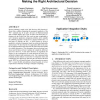Free Online Productivity Tools
i2Speak
i2Symbol
i2OCR
iTex2Img
iWeb2Print
iWeb2Shot
i2Type
iPdf2Split
iPdf2Merge
i2Bopomofo
i2Arabic
i2Style
i2Image
i2PDF
iLatex2Rtf
Sci2ools
WWW
2008
ACM
2008
ACM
Restful web services vs. "big"' web services: making the right architectural decision
Recent technology trends in the Web Services (WS) domain indicate that a solution eliminating the presumed complexity of the WS-* standards may be in sight: advocates of REpresentational State Transfer (REST) have come to believe that their ideas explaining why the World Wide Web works are just as applicable to solve enterprise application integration problems and to simplify the plumbing required to build service-oriented architectures. In this paper we objectify the WS-* vs. REST debate by giving a quantitative technical comparison based on architectural principles and decisions. We show that the two approaches differ in the number of architectural decisions that must be made and in the number of available alternatives. This discrepancy between freedom-fromchoice and freedom-of-choice explains the complexity difference perceived. However, we also show that there are significant differences in the consequences of certain decisions in terms of resulting development and maintenance cos...
| Added | 21 Nov 2009 |
| Updated | 21 Nov 2009 |
| Type | Conference |
| Year | 2008 |
| Where | WWW |
| Authors | Cesare Pautasso, Olaf Zimmermann, Frank Leymann |
Comments (0)

